Chrysanthemum - care in the fall and preparation for winter
Chrysanthemums are considered one of the most beautiful autumn garden flowers, because they begin their flowering when most of the flowers in the flower beds have already faded (or have finished blooming).
And some growers are convinced that caring for these cultivated plants is not needed either in summer or in autumn. It is necessary to understand - is it really so?
It turns out that some chrysanthemums need care in the fall and some preparation for winter. So, they need to be dug up for the winter and stored in a basement or other cool and dark room. But there are varieties of these flowering perennials that can winter well in the open field with appropriate preparation.
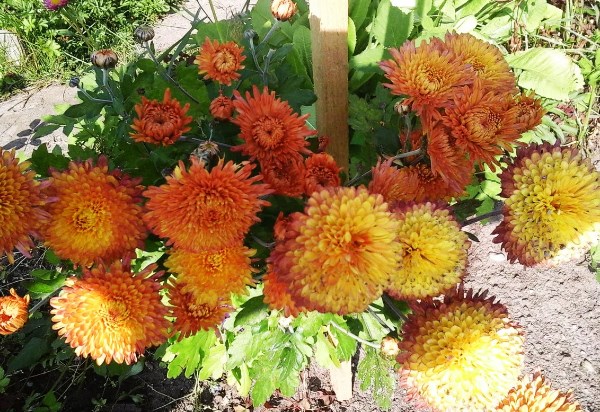
Content
Features of care in the fall and preparation for winter
To prepare chrysanthemums for winter in different regions begin at different times, starting from about the end of summer, August. Typically, caring for these flowers involves pruning, fertilizing and preparing for winter. Different types of these flowers require their own approach to wintering:
- some varieties should be dug up and stored in a dark, cool and dry place;
- and other chrysanthemums hibernate in the open field without digging up.
It is worth talking in more detail about the conduct of each of these agrotechnical measures.
Autumn pruning and fertilization
In late summer - early autumn (August-September), complex fertilizers are applied under each bush of chrysanthemums, containing potassium (less) and phosphorus (more). These elements are necessary for flowers in order for their root system to accumulate the nutrients it needs for normal wintering.
Pruning chrysanthemums in autumn is a necessary procedure that makes it easier for flower growers to shelter for the winter those varieties that hibernate in the open field. And those flowers that are removed to the basement for the winter should also be cut off - this way they are easier to store, long stems can be accidentally broken off.
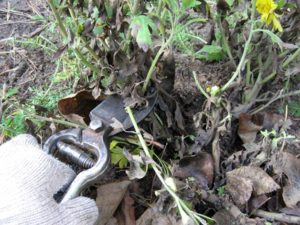
Chrysanthemum stems are cut immediately after the onset of the first autumn cold weather. In this case, the length of the cut off shoots should not exceed 14-15 cm.
How to keep chrysanthemums in winter
Unlike other flowering perennials, which are left in the open ground for the winter and practically do not cover in case of severe cold weather, chrysanthemums require special attention. They should either be dug up and put into a basement or cellar, or carefully covered before the cold weather without digging up if the variety is left for the winter in the open ground.
These activities will keep chrysanthemums in winter for active flowering in the following seasons. And it should be remembered: if you do not carry out these measures, then some perennials will simply freeze out even in a fairly warm winter.
Video: how to keep chrysanthemums in winter
What varieties winter in the open field, what kind of digging is required
To chrysanthemums that require compulsory digging, includes most varieties grown exclusively for cutting. But large-flowered (Indian) species of these flowers also do not tolerate winter well, so it is advisable to dig them up just before frost and keep them in basements.
Cut-off Indian large-flowered varieties (Golden Orpheus, Helen and similar species) are usually carefully dug up and transplanted into greenhouses, greenhouses or glazed loggias, where these flowering perennials feel great before the onset of the warm season. In regions where warm summers do not last long, it is recommended to grow cut varieties immediately in heated greenhouses or greenhouses.
But for most regions of our country (the Middle Belt, the Urals and Siberia), you can offer flower growers for breeding in their areas the following Korean (small-flowered) varieties of chrysanthemums, which can be left in the open field for the winter without digging up... The most popular ones are:
- Oak;
- Korean;
- Chamomile;
- Purple Haze;
- Malchish-Kibalchish;
- Red Moscow;
- Everest.

But in the southern regions, all types (Korean and Indian) of these beautiful flowers can be safely left to winter in flower beds - winters there are so warm that chrysanthemums do not freeze.
Conservation methods: digging and leaving in the ground with shelter
There are only two main ways to prepare these perennial flowering plants for winter:
- digging out;
- leaving in the open ground, followed by shelter.
If chrysanthemums are left to winter in flower beds, then a phased shelter of the bushes should be carried out with the onset of frost. Cut bushes should be spud so that there are no pits or depressions around them, in which water can accumulate - plants do not need excess moisture before frost. Hilling chrysanthemums should be carried out so that the cut stems are completely covered with earth.The next stage is to cover the flowers with spruce branches, dry foliage or sawdust. Chrysanthemums should be covered with these materials after the cold weather sets in (that is, in October-November).
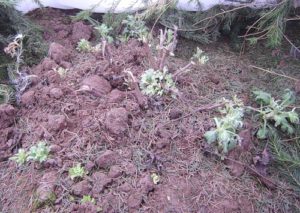
You can also use slate or iron sheets as cover. A "wall" of several rows of bricks is laid around the bushes, on which sheets of slate are laid. Such a shelter does not allow water or snow to enter, but is a well-ventilated structure.
Important! Thus, Korean (small-flowered) chrysanthemums must be sheltered in the Leningrad Region, the Middle Belt (Moscow Region), in the Urals and in Siberia.
Video: how to cover chrysanthemums for the winter
Features of the conservation of spherical and dwarf chrysanthemums
Spherical chrysanthemums were bred by breeders relatively recently, this species is intended for decorating garden plots or balconies and loggias in an apartment. If such varieties grow in the open field during the summer season, then in order to preserve the globular chrysanthemums in winter, you need to worry about how to properly prepare the plant for the cold. In the southern regions, it is enough to cover these perennials with straw or spruce branches. But in colder areas, it is recommended to dig them out before the onset of cold weather. As soon as the aerial part is completely dry, the globular varieties should be dug up, slightly dried in the shade, cleaned of the ground, removed dried shoots and placed in containers filled with straw or sawdust. Store the rhizomes in a cool, dark place until spring.
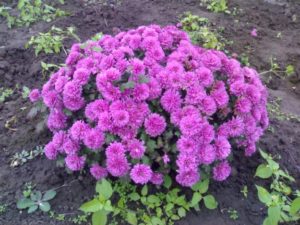
Dwarf chrysanthemums are mainly intended for indoor cultivation, but they are also grown outdoors.... If these flowers grow on a balcony, in an entrance or in a room, they should be cut off before winter, leaving stems no more than 10 cm long.Then the plant is placed in a bright room, the temperature in which is kept about +8 C, watering every 25-30 days ... If this is not possible, then you can keep trimmed chrysanthemums in the room in winter, watering in the same way as in summer.
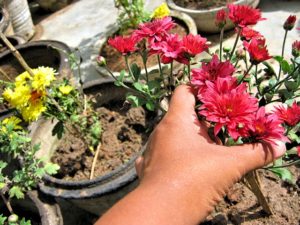
Not all types of dwarf chrysanthemums can hibernate in the open field. And if the florist has decided not to dig up these flowering plants, then they should be well covered with the onset of frost. To do this, cut the stems to a length of 10-12 cm, cover with earth or peat (always dry) or foliage. And cover with any covering material on top.
Typical mistakes in caring for chrysanthemums in the fall and preparing for winter
The main mistakes that flower growers make when caring for chrysanthemums in the fall may be as follows:
- do not apply top dressing for flowers in late summer - early autumn;
- do not dig for the winter those varieties that should be kept indoors during the cold season;
- incorrectly produce shelter for these perennials wintering in open ground.
Caring for chrysanthemums in the fall and preparing these flowers for winter is not a very laborious process. However, improperly performed procedures to preserve these beautiful flowers can lead to the fact that the plants will freeze. And only compliance with all the rules for caring for chrysanthemums will allow you to preserve these flowers in the winter in order to enjoy their flowering again next year.
Video: caring for chrysanthemums in the fall and preparing for winter


Very interesting and useful information